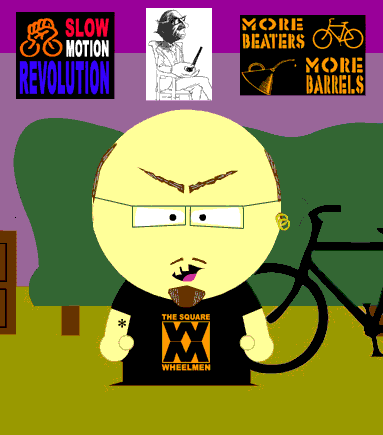Agents of change...
a different view
on Critical Mass
on Critical Mass

Over at Geez Magazine, Aiden Enis takes a deep look at the 12 personality types that make up the progressive movement in the US. It got me thinking about the different personalities you encounter during Critical Mass. So below are his types (italicized) followed by my ideas of how they apply to massers.
Vanguardists: These are folks who aim to break through the public’s consciousness with a “better way to go.” Often in the limelight, these folks are hard core: high principles, lots of sacrifice and noble aims. They sometimes see compromise as caving and tend to sneer at incremental change, or “change from within".
Embodiment politics: Right behind those on the vanguard is an often quiet community of activists living out what I’ll call “post-turbo-capitalist” ways ... These people engage in “prefigurative politics,” a term Cynthia Kaufman uses in her excellent primer on the theory of social change, Ideas for Action: Relevant Theory for Radical Change, (South End Press, 2003). This group assumes “we should act right now as if we were living in the better world we are fighting for,” she says. This means, for example, creating structures without hierarchy, striving toward consensus decision making, and being conscious of environmental impact.
Culture jammers: If you’ve ever seen a stop sign adorned with a “shopping” sticker in bold letters, you’ve witnessed the work of a culture jammer. These are folks who take the discourse of consumer culture, direct it at itself and allow the beast of consumer capitalism to bite its own tail.
Culture workers: These folks change the world from the bottom up. Rather than focusing energy on the upper echelons of power – self-serving businessmen, government cronies and rogue military commanders – these people focus on concrete ways to change the culture. This thinking stems from Antonio Gramsci, who used the word “hegemony” to describe how a population can consent to its own oppression. There’s always a tension between strong leaders (fascist or otherwise) pushing people around, and the people agreeing to go.
Independent media: A simple exercise will prove the point that our culture is dominated by a few commercial media conglomerates: Google the phrase “who owns what” and come to a site from Columbia Journalism Review that lists the top 20 or 30 companies that own almost everything in the North American media and entertainment industry.Xerocracy at its best -
when someone volunteers to put together The Dérailleur, CCM's unofficial monthly newsletter, or to pass it out before each mass begins.
Coalition builders: Change happens when people organize. Civil society, in the form of non-profits, NGOs or public interest research groups (PIRGs), can influence government policy (e.g., lobby for a higher minimum wage or rent controls). Or, they can create independent community services, like art classes in the inner city, cooking skills for low-income folks, health care, and tutoring.
Insider allies: The ranks of the middle and upper classes and other privileged groups have well-meaning individuals who want to share power. Some of these folks may even favor radical change, change that challenges their own power. They’re convinced major change happens when people on the inside of major institutions act as catalysts.
Defectors: Among the ranks of every bastion of power, there are individuals who smell hypocrisy and hit eject. They become experts for how not to do things. Defectors pop out from all over the place ... Others, like anarcho-primitivists, for example, wish to defect from industrial civilization altogether, favoring small-scale, rural off-the-grid living.
Dissenters: Unlike defectors, who first enjoy mainstream status and then abandon it, dissenters speak out, often from the margins of their social group. Most newspapers, schools, churches and governments have their radicals/mavericks/ loudmouths – they usually get tagged with a label of some sort. While annoying to many, these individuals often articulate frustration from below, problems with the status quo.
Disruptives: Here the explicit strategy is to impede business as usual. To compare: Culture jammers disrupt but don’t force it on others. Dissenters offer subversive speech but leave the actions to others. Disruptives see the need for action now, and step in the way to impede business as usual. Disruptives often enter the circle of power from a location on the fringe. A good example is when hundreds of cyclists merge on a street and flop to the ground in a “die-in.”
Cultural creatives: It’s worth mentioning this group as evidence of the “mainstreaming” of alternative values. Here we have concern for the environment, aversion to advertising, downplay of luxury living, and a spiritual sense of our interconnectedness. They eat organic, ride nice bikes, give to progressive charities and read enlightening magazines (like Utne, Yes! and Geez). While they would claim to be making a broad cultural shift, sometimes it seems they trust radical change will just happen, or leave it to others to initiate. According to Paul Ray and Sherry Ruth Anderson, authors of The Cultural Creatives, there are 50 million of these “optimistic, altruistic” people in the US.Contemplatives: These are folks who occupy a subversive presence in both consumer culture and activism because they are able to curb desire and address root causes ... these people are a source of sustenance for the movement.Bike hipsters who lurk daily on the CCM listserve and bitch once a year (usually in summer) that the last mass they were on wasn't political enough.
Labels: Chicago, critical mass, pensées, politix

















0 Comments:
Post a Comment
<< Home